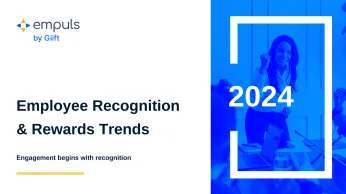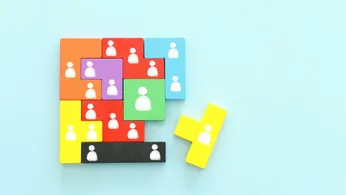Sur cette page
- What is recognition?
- Qu'est-ce que la gratitude ?
- Why is it important to create a culture of recognition and gratitude in the workplace?
- Benefits of building a culture of recognition and gratitude in your workplace
- 10 Ways to create a culture of recogniton and gratitude in the workplace
- How Empuls fuels a culture of recognition and gratitude
Imagine walking into work every day knowing your contributions matter—that your effort isn’t just noticed, but genuinely appreciated. That’s the power of a culture of recognition and appreciation.
And it couldn’t be more relevant today. In a recent survey by McKinsey, 40% of employees reported they were likely to leave their current job in the next 3–6 months, as the Great Resignation shows no signs of slowing down. Employees are no longer just chasing paychecks—they’re seeking purpose, belonging, and to feel valued in their work.
This is where building a culture of gratitude becomes your secret weapon. It’s not about one-off perks or token gestures. It’s about making gratitude and recognition a daily ritual—woven into the way teams collaborate, celebrate, and grow together.
So, how do you create a culture of recognition that doesn’t feel forced or forgotten? One that energizes people, boosts retention, and inspires them to do their best work?
This blog is your blueprint. Let’s explore why recognition and gratitude matter more than ever—and how to make them the heartbeat of your workplace culture.
What is recognition?
Recognition, in general, is acknowledging all the positive things in life, such as the goodness in other people, events, and experiences. Employee recognition acknowledges employees' inherent value, not just their work performance.
Building a culture of recognition involves acknowledging the contribution of employees for their meaningful impact on the bigger picture. Whether it is thanking them for a job well done or recognizing their efforts to help other departments or a member in need, employee recognition encompasses it all.
Qu'est-ce que la gratitude ?
Gratitude, a close sibling of recognition, takes a step further to recognize the influence of outside forces on our success.
The word gratitude is derived from Latin and means 'thankfulness'; therefore, it can also be thought of as a 'thankful recognition.' Gratitude in the workplace is the foundation of trust, empathy, and communication, all of which are the most sought-after attributes of a strong organizational culture.
Why is it important to create a culture of recognition and gratitude in the workplace?
Human beings are social animals, and relationships are fundamental to any group structure–be it a family, a group of friends, or colleagues. Unfortunately, in the middle of hectic work cycles, employees get little time to bond to the team and organization in productive ways.
A culture of recognition and gratitude fills in the gaps by engaging employees in thank-you activities that build trust while making them feel valued. At an organizational level, a culture of recognition and gratitude is closely tied to productivity, engagement, and employee retention.
Benefits of building a culture of recognition and gratitude in your workplace
Building a culture of recognition goes beyond handing out praise—it's about creating a workplace where people feel seen, valued, and motivated to do their best. Here are a few key benefits that come with making recognition part of your everyday work culture.
1. Elle peut améliorer le moral des employés et leur satisfaction au travail
When the employees of an organization are appreciative of one another, it has the effect of lifting employee morale. It motivates them to work as a team and improves job satisfaction on the whole.
2. Il réduit le stress et l'absentéisme
Une culture de la gratitude donne aux employés le sentiment d'être appréciés, ce qui réduit l'insécurité de l'emploi et le stress qui y est associé. La diminution de la tension dans l'environnement de travail réduit également les congés de maladie et encourage les gens à se présenter au travail.
3. Il accroît la productivité des employés
Les employés qui sont régulièrement appréciés par leurs managers et leurs pairs sont plus confiants et engagés dans leur travail. Ces employés heureux sont désireux d'être plus performants et de conserver leur rôle d'employés appréciés.
4. Il augmente la rétention des employés
Productive and engaged employees with the strong work culture of gratitude are satisfied with their job. Moreover, having such stability and nurturing atmosphere at work can significantly reduce employee turnover.
5. Il permet d'attirer les talents
Une culture d'entreprise forte fait des employés des ambassadeurs de l'organisation, ce qui contribue aux efforts de recrutement. En outre, le bouche-à-oreille d'employés heureux améliore la proposition de valeur de l'employeur et attire les meilleurs talents.
10 Ways to create a culture of recogniton and gratitude in the workplace
The key to unlocking higher levels of engagement, happiness, and productivity in the workplace lies in creating a culture of appreciation and gratitude. So, here are some important tips on how to build a culture of appreciation and gratitude at work:
1. Envoyez rapidement des notes et des courriels de remerciement
Whether for closing a deal, securing new business, achieving goals, or generating new ideas, make it a habit to send thank you notes and emails. Being prompt with your appreciation shows your employees that you are grateful for their efforts and value their presence in the workforce. To make it highly effective, send out the email immediately after an event or write a hand-written note to make it extra memorable.
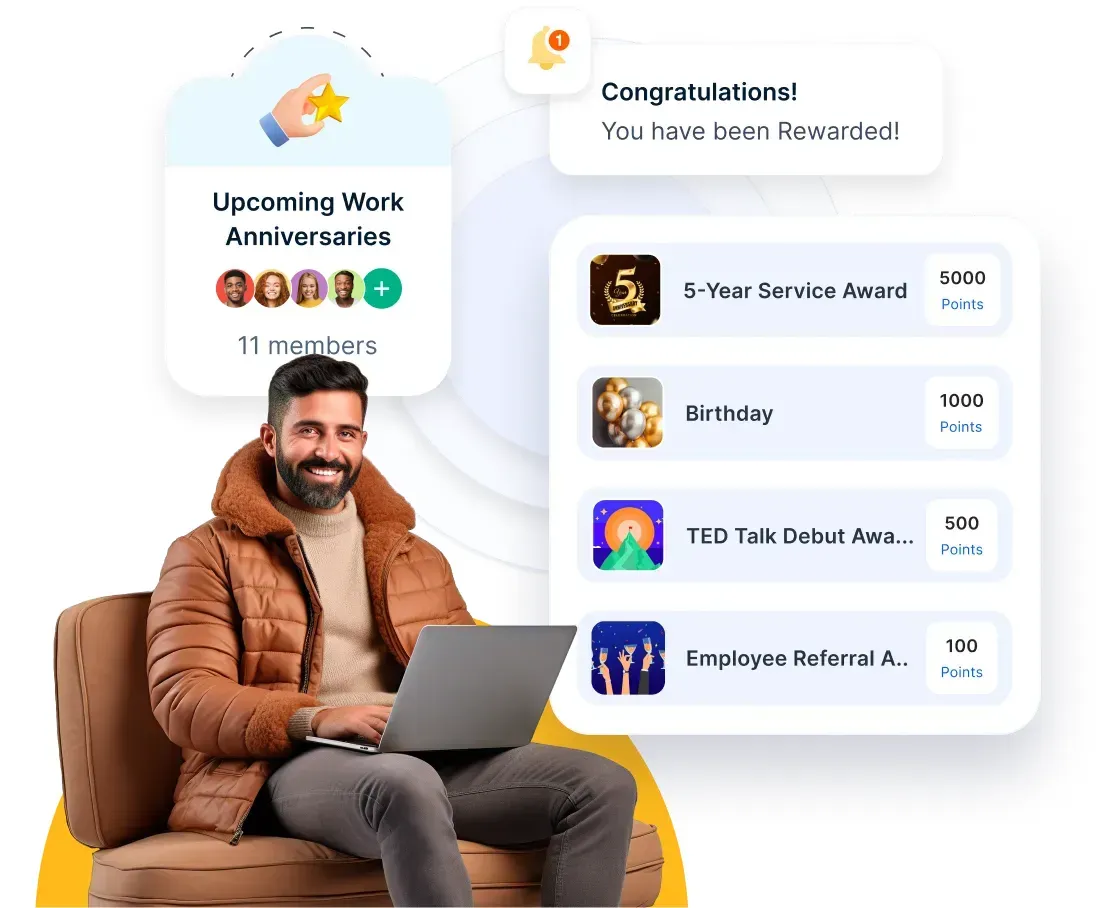
Automate thank-yous and milestone celebrations with ease
Why wait to say thanks? Empuls makes it easy to send automated appreciation messages and gifts for birthdays, work anniversaries, project completions, and more. With built-in workflows and smart nudges, you can ensure that no moment of recognition slips through the cracks.
Learn More
2. Personnalisez votre approche de l'appréciation
L'appréciation est plus efficace lorsqu'elle est délivrée de manière hautement personnalisée. Si la personnalisation en soi a un impact important, le fait d'apprécier les employés de la manière dont ils aiment être appréciés peut faire toute la différence.
Par exemple, si certains sont ravis d'un simple mot de remerciement, d'autres attendent un cadeau tangible ou une reconnaissance publique de leur réussite. La façon de déterminer leur langage d'appréciation est d'observer comment ils apprécient les autres. Les managers et les chefs d'équipe auront une vision personnalisée des membres de leur équipe qui leur permettra de déterminer la meilleure façon d'apprécier chaque individu.
3. Célébrez les petites et grandes victoires.
La célébration des grandes victoires est nécessaire pour rompre la monotonie des longues durées de projet et rendre aux employés une passion, une plongée et une concentration accrues. Les grandes célébrations sont aussi l'occasion pour les employeurs de faire preuve de créativité dans leurs récompenses. Les petites victoires méritent également d'être célébrées car elles ouvrent la voie aux grandes victoires.
Le secret pour maintenir le moral est de diviser la tâche en petits morceaux et d'apprécier fréquemment chaque petite victoire. De petites et fréquentes félicitations dans le dos sont ce qui permet aux employés de rester productifs.
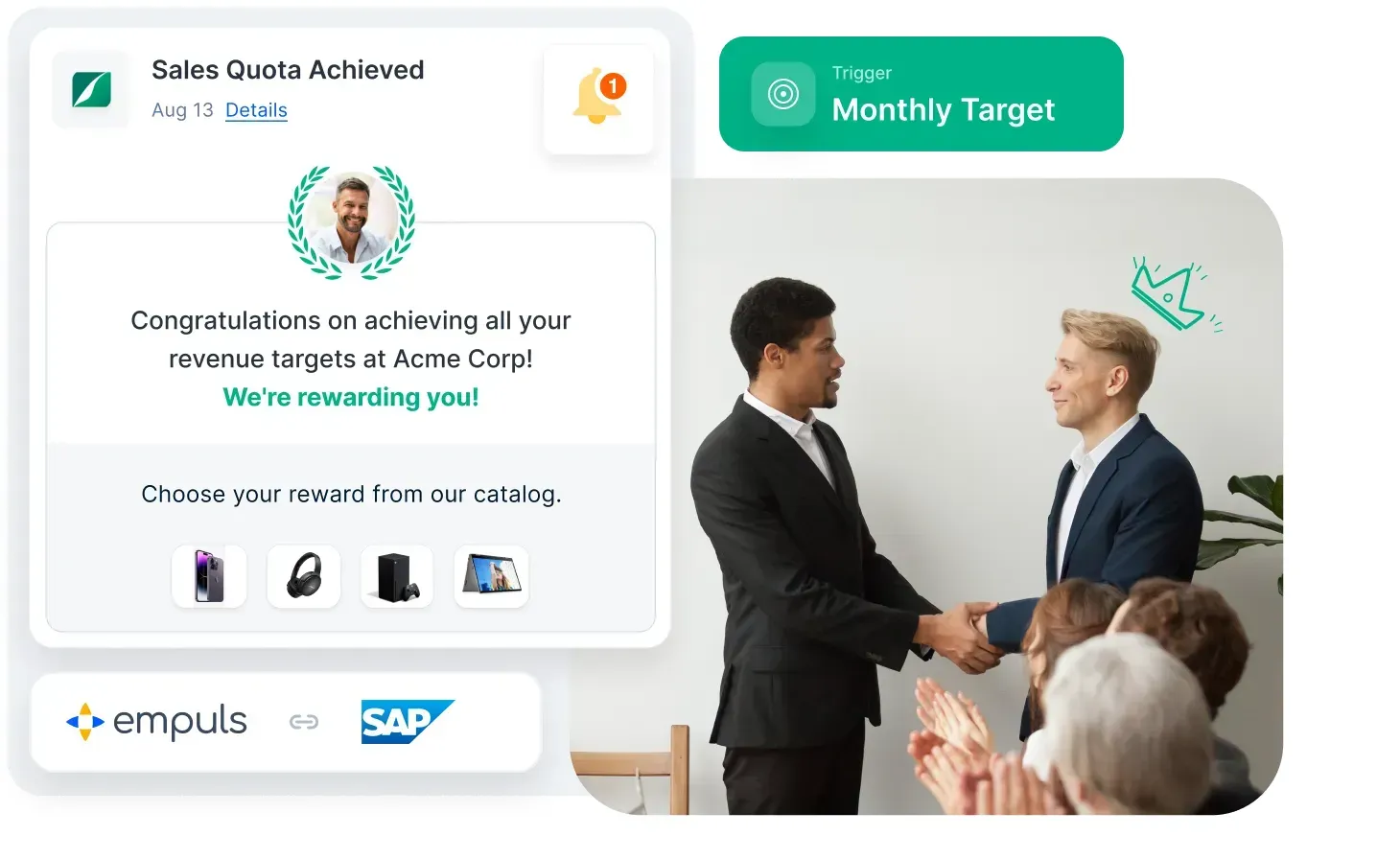
Celebrate wins—big and small—with visibility
Empuls’ company-wide social feed turns individual accomplishments into collective celebrations. From shoutouts to wishboards, every win can be broadcast to boost morale and motivate others to follow suit.
4. Incorporer la gratitude dans le leadership
Les leaders de la direction d'une organisation sont chargés de guider les individus et les équipes vers les objectifs de l'organisation. Cependant, avec le stress et l'anxiété liés à la nécessité de réagir au paysage commercial dynamique, les dirigeants ont rarement le temps d'apprécier leurs équipes.
Cette situation est encore exacerbée par le manque de confiance de nombreux employés envers la direction. Les dirigeants peuvent renforcer le moral et la confiance des employés en organisant des séances de compte rendu de la gratitude après la fin du projet et en appréciant activement et périodiquement la contribution de chacun.
Since implementing this personalized approach, we've observed a 35% increase in employee engagement and a 25% decrease in turnover rates. This strategy has also positively impacted our customer relations, with a 20% boost in repeat customer interactions. These figures underscore the significance of a leadership style that's not just about guiding, but genuinely appreciating each individual's contribution to our collective success.
5. Intégrez la gratitude dans vos récits
Your social media posts, blog content, podcasts, vlogs, and newsletters form the narrative about your organization. Weaving gratitude into your stories is a component of building a culture of employee appreciation. Include stories that talk about the contribution of your employees to your success in a tone that is highly appreciative and grateful. Talk about gratitude as part of the organization’s culture from the top down and across.
6. Créez des occasions d'exprimer votre gratitude
Pour construire une culture de la gratitude, tout le monde doit avoir l'occasion de participer. Ce changement peut prendre la forme de réunions informelles, tous les mois ou toutes les semaines, au cours desquelles chacun prend la parole pour exprimer sa gratitude à des personnes ou à l'ensemble de l'équipe.
Other exercises can include writing a gratitude journal, leaving anonymous gratitude notes on a notice board, or gratitude box entries for something good that happened at home or work. Employee rewards and recognition programs established by organizations are also a great way to reinforce a culture of appreciation.
7. Mettre en valeur les meilleures qualités des individus
La création d'une culture d'appréciation des employés est incomplète si l'individu n'est pas mis en valeur. Apprécier les meilleures qualités de chaque employé est l'un des moyens, sinon le plus puissant, de faire ressortir le meilleur de la personne.
Appréciez les qualités rarement reconnues telles que l'honnêteté, la reconnaissance des erreurs et la volonté d'apprendre et de changer. Un exercice allant dans le même sens pourrait consister à donner à chaque employé la possibilité de s'asseoir à tour de rôle sur la "chaise électrique de l'appréciation" pendant que les membres de son équipe parlent de leurs meilleures qualités.
8. Remerciez ceux qui sont rarement appréciés
Toutes les organisations ont des employés qui sont rarement ou peu reconnus pour leur travail qui permet à la machinerie organisationnelle de fonctionner sans heurts. Il s'agit notamment des personnes qui occupent des fonctions de soutien, comme le personnel des TI, des RH, de la comptabilité, de l'entretien et de la conciergerie.
Les remercier périodiquement est essentiel à l'instauration d'une culture de l'appréciation, car cela met en évidence l'interdépendance des différents départements d'une organisation. Soyez authentique en appréciant les héros méconnus, et vous remonterez le moral de tous les membres de l'organisation.
9. Promote peer-to-peer appreciation
Although appreciation by the managers and leaders is significant, peer-to-peer appreciation has a more profound impact. Employees in every team share a sense of comradery and the highest honor one can receive is to be recognized and thanked as an important team member. Establishing peer-to-peer recognition programs can solidify your efforts toward building a culture of appreciation and gratitude.
Empuls empowers everyone to participate in creating a culture of gratitude through peer-to-peer recognition tools. Employees can give kudos, send hi-fives, and nominate peers for awards—strengthening camaraderie and trust across teams.
10. Build a culture of appreciation in the workplace
Employee recognition is central to creating a culture of appreciation at the workplace. Recognition of employees involves recognizing not only the outcomes but also the efforts and the progress.
Public recognition in the form of company-wide shoutouts boosts the morale and self-esteem of employees. Recognition can take the form of congratulating on completing projects, reaching milestones, or even a simple “thank you.”
How Empuls fuels a culture of recognition and gratitude
Want to make recognition second nature at your workplace? That’s where Empuls steps in.
Empuls isn’t just another HR tool—it’s your all-in-one sidekick for sparking joy, boosting morale, and creating those "you matter" moments across the organization. It makes recognizing and rewarding your team as easy (and fun) as sending a GIF.
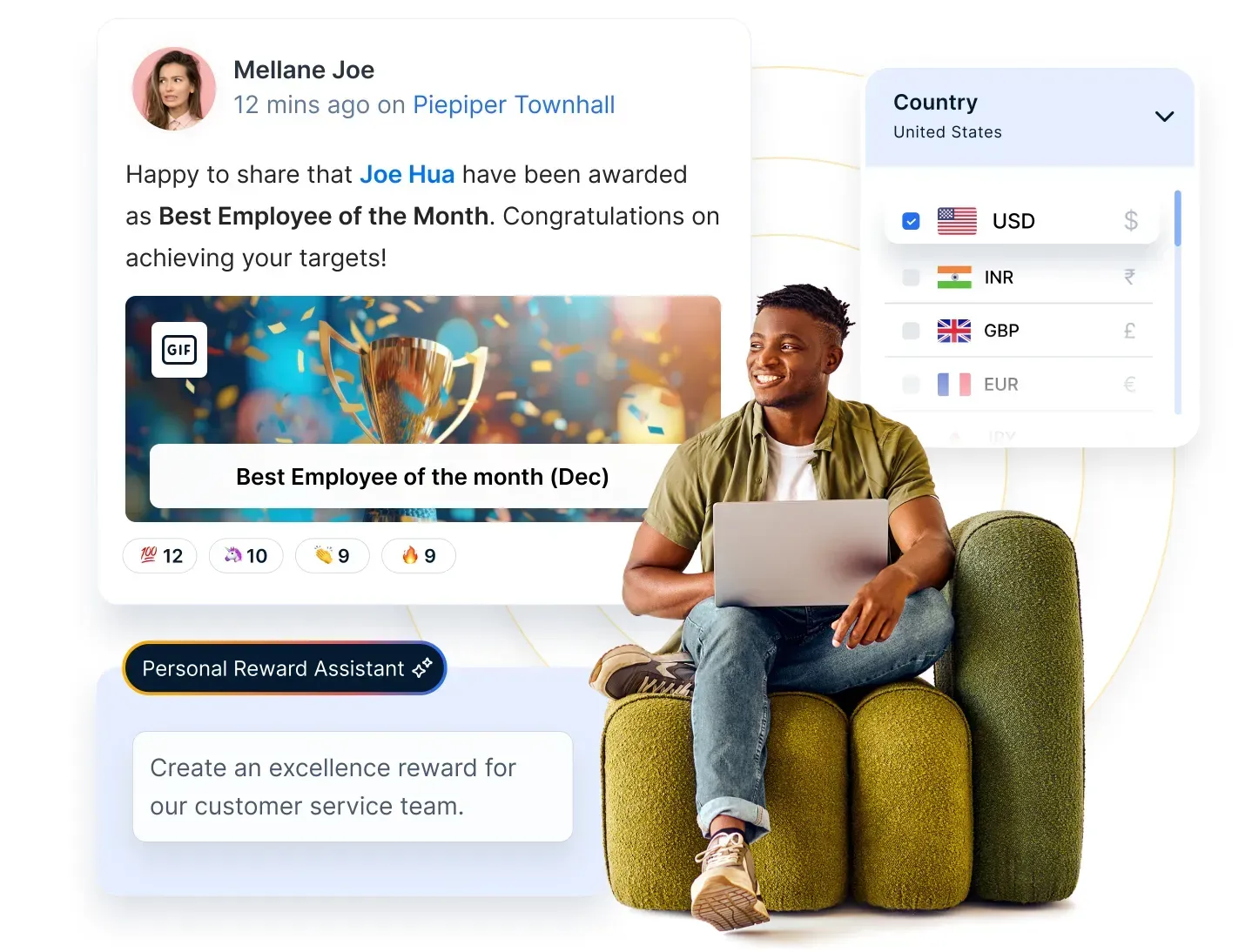
Here’s how Empuls helps you build a culture where gratitude flows and recognition shines:
- Recognize in real time With smart nudges and seamless workflows, Empuls makes it easy to appreciate someone the moment they go above and beyond—no more “I’ll thank them later” moments.
- Make every milestone magical: Birthdays, work anniversaries, service milestones—you name it, Empuls celebrates it. From automated wishes to curated rewards, it's all taken care of.
- Peer-powered positivity: Give everyone a voice. Empuls enables peer-to-peer shoutouts, hi-fives, and appreciation badges, turning teammates into cheerleaders.
- Recognition that’s actually rewarding: Choose from a global catalog of gift cards, experiences, wellness perks, charity options, and more. Recognition becomes personal, memorable, and meaningful.
- Let AI do the heavy lifting: Em, the AI assistant, helps managers spot recognition gaps so that no one feels left out. It’s like having a gratitude compass built right into your culture.
Put recognition in the spotlight: From townhalls to social feeds, Empuls turns recognition into a shared celebration. Everyone sees it, feels it, and wants to be a part of it.
Book a demo with Empuls today and start turning everyday moments into reasons to celebrate.
Réflexions finales
As social animals, we are wired for acceptance, recognition, and gratitude from our peers. To establish a culture of gratitude, it is essential to start from the top-level management and let it trickle down to teams and individuals.
A culture of recognition takes time to establish, but once embedded, it builds trust, strengthens teams, and fosters lasting engagement. Over time, people begin to believe in it—and that’s when it becomes a true culture, not just a practice.








